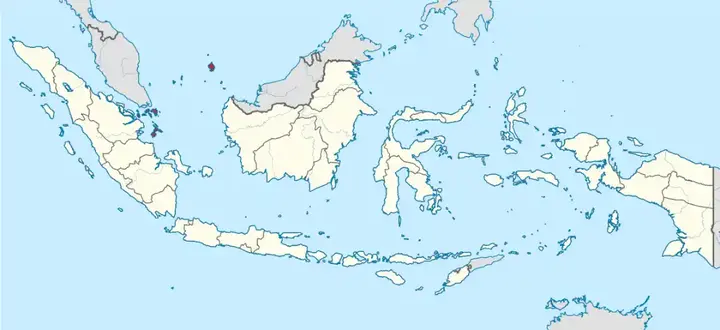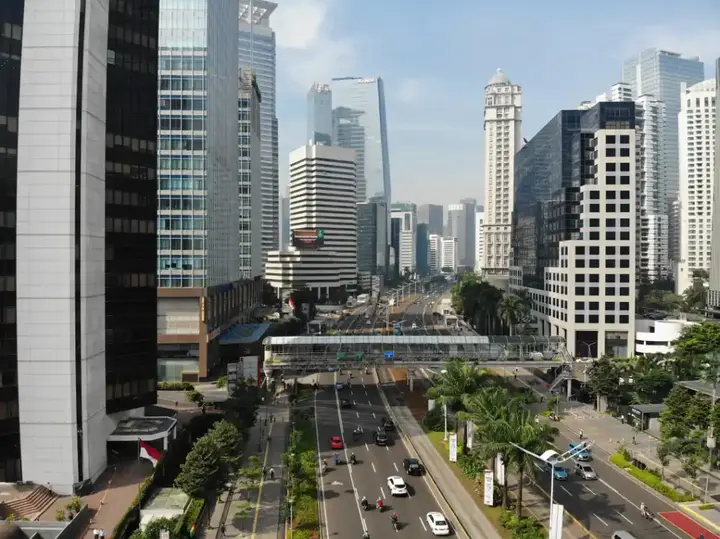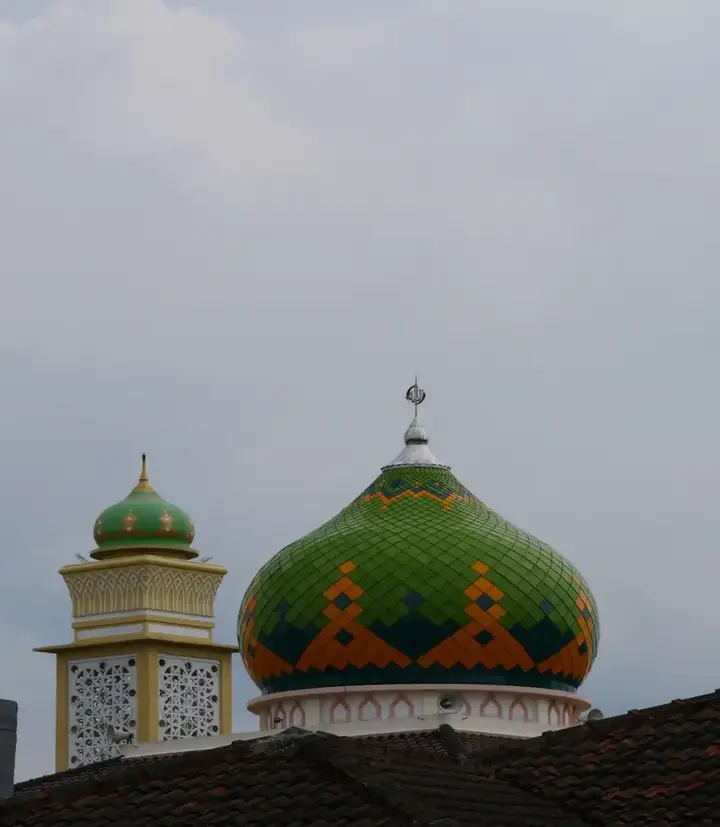Islam in Indonesia - its emergence and present - the role of trade and tourism

Today, Indonesia is home to the largest Muslim population in the world, as Islam is deeply rooted in the country's history, culture, and identity. The history of Islam in Indonesia is a rich tapestry of cultural exchange, trade networks, religious movements, and political dynamics. In fact, the spread of Islam in Indonesia was a startling historical process that resulted from a multifaceted dynamic that unfolded over several centuries, shaped by a complex interplay between historical, cultural, economic and political factors. In this article, we provide an overview of how Islam arrived and spread in Indonesia.
Show key points
- Islam first arrived in Indonesia between the 7th and 13th centuries through maritime trade routes linking the archipelago with Arabia, Persia, India, and China.
- Coastal communities began converting to Islam between the 13th and 16th centuries, driven by trade relations, intermarriages, and cultural assimilation.
- The conversion of local elites and rulers significantly boosted the spread of Islam, as it provided political and economic advantages and legitimized their authority.
- ADVERTISEMENT
- Sufi missionaries played a pivotal role in making Islam appealing to Indonesians by harmonizing Islamic teachings with local spiritual beliefs and practices.
- The rise of Islamic sultanates and kingdoms from the 13th to 17th centuries institutionalized Islam and made it central to political and cultural life.
- Islam in Indonesia was adapted through syncretism, blending with indigenous customs and traditions to form a uniquely local expression of the faith.
- Islamic revival during colonial times revitalized religious practices and educational institutions, positioning Islam as a key force in anti-colonial movements and nation-building.

1- Early commercial contacts (between the seventh and thirteenth centuries):
Recommend
Maritime trade routes in the Indian Ocean and the South China Sea served as conduits for the transmission of early Islam to Indonesia; the Indonesian archipelago, located at the crossroads of major maritime trade routes, has been a center of commercial activity since ancient times. The earliest contacts between Indonesia and the Islamic world date back to the seventh century, when Muslim merchants began traveling from Arabia, Persia (modern Iran), India and China via these trade routes, connecting diverse regions of the Indian Ocean and the South China Sea, bringing with them Islamic teachings and cultural influences, establishing trading settlements and engaging in cultural exchange with local communities. Through these interactions, Islam gradually spread to coastal areas and commercial ports, where the presence of Muslim communities became a catalyst for the spread of Islamic teachings.
2- Conversion of coastal communities to Islam (between the thirteenth and sixteenth centuries):
Initially, Islam took root in commercial ports and coastal urban centers, where Muslim merchants established trading centers, small communities, and ran their businesses. These malls have become centres not only for economic activity, but also for cultural exchange, attracting merchants, artisans and travellers from diverse backgrounds. Coastal communities converted to Islam through a variety of factors, including trade relations, mixed marriages, and cultural assimilation; Muslim merchants often married local women and integrated into existing social networks, while promoting cultural exchange and interfaith reconciliation. As Islam gained a foothold in the coastal areas, it began to spread inland through trade networks, missionary activities, and the influence of Muslim and Sufi scholars.
3- Local elites and rulers converted to Islam (between the thirteenth and sixteenth centuries): Muslim merchants often interacted with local elites, rulers and aristocrats, who wielded political power and controlled trade routes and resources. The conversion of local elites to Islam played a crucial role in the spread of Islam in Indonesia, where rulers converted to Islam for political, economic and social reasons. By embracing Islam, rulers can forge alliances with Muslim merchants, gain access to international trade networks, and legitimize their power through religious affiliation.
By the fourteenth century, Islam was established in northeastern Malaya and in some coastal tiles in eastern and central Java, and by the fifteenth century, in Malacca and other areas of the Malay Peninsula.The fifteenth century saw the decline of the Hindu Magapahit Empire in Java, as Muslim merchants from the Arabian Peninsula, India, Sumatra and the Malay Peninsula, as well as China, began to control the regional trade previously controlled by Majapahit Javanese merchants.
4- Sufi influence (between the thirteenth and sixteenth centuries):
Sufism, with its emphasis on spirituality, tolerance and universal love, also played an important role in the spread of Islam in Indonesia through the influence of Sufis who came to the region to spread Islamic teachings. It found resonance with the indigenous beliefs and cultural practices of the Indonesian people, making it more accessible and attractive to locals. Missionaries also had a great influence in spreading the Islamic religion through personal example and spiritual guidance.
5- The role of Islamic kingdoms and sultanates (between the thirteenth and seventeenth centuries):
The establishment of Islamic kingdoms and sultanates in Indonesia accelerated the spread and consolidation of Islam, as Islam became the official religion and the basis of political legitimacy. Rulers such as the sultans of Malacca, Aceh, Demak and Mataram embraced Islam and exercised political power to promote its spread. These new Islamic kingdoms became centers of religious science, commerce and cultural exchange, attracting scholars, merchants and immigrants from all over the Muslim world, contributing to the spread of Islam throughout the region, and playing a crucial role in shaping Indonesia's religious landscape and fostering a sense of Islamic identity among its diverse population.
6- Adaptation and reconciliation of beliefs (between the fourteenth and eighteenth centuries):
The spread of Islam in Indonesia was characterized by adaptation to existing local beliefs and traditions, merging Islamic beliefs and practices with existing indigenous traditions. This syncretistic approach allowed Islam to coexist between religious beliefs and diverse cultural expressions within Indonesian society. For example, elements of Hindu-Buddhist cosmology, pagan rituals, and local folklore have been incorporated into Islamic rituals and festivals, leading to the emergence and development of unique forms of religious expression such as "Islam Nusantara" or "Indonesian Islam" that incorporates elements of indigenous culture, spirituality, and Hindu-Buddhist traditions. This syncretistic approach allowed Islam to coexist between diverse religious practices and cultural expressions within Indonesian society.
7- Islamic educational institutions and scholarships (between the fourteenth and eighteenth centuries):
Islamic educational institutions, such as Islamic boarding schools and mosques, have played a vital role in the transmission of Islamic knowledge and teachings. These institutions served as educational centers, where students studied the Qur'an, Hadith, Islamic jurisprudence, and other religious subjects under the supervision of scholars and teachers. Islamic science flourished in Indonesia, producing renowned scholars who contributed to the intellectual and cultural development of Islamic society.
8- Colonialism and Islamic Revival (between the seventeenth and twentieth centuries): The arrival of European colonial powers, especially the Dutch, in the seventeenth century brought new challenges and opportunities to Islam in Indonesia. The Dutch controlled Indonesia's main ports, and Muslim merchants were forced to distance themselves to small, remote ports, further contributing to the spread of Islam in those areas. The imposition of restrictions by colonial rule on Islamic practices and institutions strengthened resistance movements and Islamic revival. The nineteenth and twentieth centuries saw the emergence of modernist and reformist movements within Indonesian Islam, as well as the establishment of Islamic educational institutions and organizations. By the beginning of the twentieth century, Islam became the largest actor in the resistance to colonialism. The colonial period also witnessed a great opening of Indonesia to the world and to other Islamic regions, especially the Middle East, as a result of the development of maritime transport, communications and the introduction of printing presses into the country. The number of pilgrims to Mecca increased dramatically, and many students went to study in the Middle East, returning to study in Indonesian religious schools with innovative ideas.
9. Independence and nation-building (20th century to present): The struggle for independence in Indonesia, which culminated in the Declaration of Independence in 1945, provided new opportunities to promote Islam as a cultural and political force. Since its independence, Indonesia has been the second largest Muslim country in the world, and after the separation of Bangladesh from Pakistan it became the largest Muslim country. The Indonesian state has adopted Pancasila as its founding philosophy, which emphasizes religious pluralism and tolerance, allowing for coexistence between diverse religious communities within a unified national identity.

Today, Indonesia is home to the world's largest Muslim population, as Islam is deeply ingrained in the country's history, culture and identity.
The role of tourism:

Tourism may not directly affect the spread of Islam in Indonesia in the same way as historical trade networks or missionary activities, but it plays a role in promoting awareness, appreciation, and understanding of Islam among tourists and travelers. Tourism by showcasing Indonesian Islamic heritage, cultural traditions and religious values contributes to the preservation and promotion of Islam in the country. Here are some of the ways tourism may affect the spread of Islam in Indonesia:
1- Islamic tourism sites: Indonesia is home to many Islamic heritage sites, including mosques, shrines of saints, and historical monuments associated with the spread of Islam in the archipelago. These sites attract local and international tourists interested in exploring the country's Islamic history and heritage. Visiting these sites can provide tourists with insight into the history, culture, and religious significance of Islam in Indonesia, which could lead to a greater appreciation and understanding of the religion.

2- Hajj and religious tourism: Indonesia is known for its rich traditions of religious pilgrimage, including visiting holy sites and shrines associated with Islamic saints and spiritual leaders. Hajj tours, organized by travel agencies and faith-based organizations, allow pilgrims to visit these sites and participate in religious rituals and ceremonies. Hajj tourism contributes to the promotion and preservation of Indonesia's Islamic heritage, as well as the dissemination of religious teachings and practices among pilgrims.
3- Cultural exchange and interfaith dialogue: Tourism provides opportunities for cultural exchange and interfaith dialogue between Muslims and followers of other religions. Tourists visiting Indonesia may encounter Islamic customs, traditions and practices during their travels, leading to intercultural interactions and mutual understanding. Interfaith dialogue initiatives, organized by tourism authorities and faith-based organizations, promote peaceful coexistence and cooperation between people of different religious backgrounds.
4- Promoting Islamic values: Tourism can serve as a platform to promote Islamic values such as hospitality, generosity and tolerance. Muslim-majority areas in Indonesia often prioritize halal tourism, which caters to the needs and preferences of Muslim travelers by offering halal food, prayer facilities, and accommodations that comply with Islamic principles. Halal tourism initiatives aim to create welcoming and inclusive environments for Muslim tourists, reflecting the values of Islam in the tourism industry.
5- Educational and Cultural Exchange Programs: Tourism facilitates educational and cultural exchange programs that promote intercultural understanding and awareness of Islamic teachings and practices. Islamic schools, universities and cultural centers can organize study tours, exchange programs and cultural immersion experiences for students and tourists interested in learning about Islam in Indonesia. These programs contribute to the dissemination of knowledge about Islam and promote intercultural dialogue and cooperation.

In the end, while tourism as we know it today did not exist during the initial spread of Islam in Indonesia, the modern tourism industry has had an impact on the practice and perception of Islam in the country.








